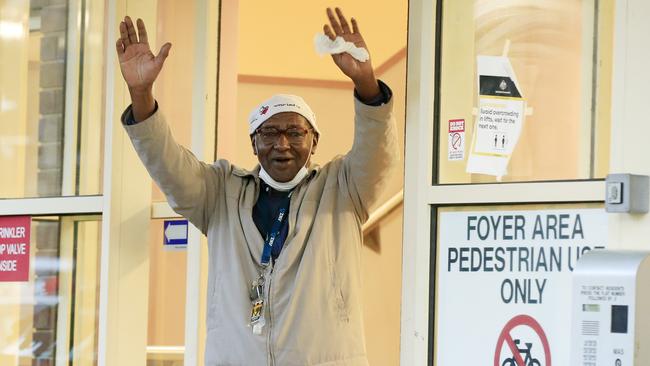Coronavirus: Victoria took tracing rules short-cut
Victorian health officials did not adhere to national guidelines that specify close contacts be followed up daily for flu-like symptoms.

Victorian health officials did not adhere to national guidelines for COVID-19 contact tracing that specify close contacts should be followed up daily for flu-like symptoms, a breakdown that led to surging transmission rates of the virus requiring a lockdown of metropolitan Melbourne.
The deficiency has been identified by the Australian Health Protection Principal Committee as one of several “areas of improvement” in their assessment of what happened in Victoria.
The AHPPC, an independent agency, has provided advice and recommendations to Victoria’s Department of Health and Human Services over its handling of the pandemic’s second wave.
“Every case, every day, must be followed,” said a senior health official familiar with the matter.
“It is the national standard. We have highlighted the areas of improvement through the AHPPC.”

The Australian reported on Thursday that the smaller size of the Victorian public health workforce — those trained in contact tracing — was largely responsible for its struggle to contain the second wave of infections.
Victoria recorded 165 new cases on Thursday, taking the weekly increase to 847 infections.
Residents in one of nine public housing towers in Melbourne locked down on Sunday will be forced to remain in police-enforced quarantine for another nine days, with at least 53 infections detected at the North Melbourne block. Up to 25 per cent of residents could contract the virus.
Residents of the other towers have been allowed out under the same rules as the rest of the city.
The smaller number of specialists left the department scrambling to track down potential cases of transmissions and limited its ability to train up extra personnel at a scale to replicate the work.
As a result, hundreds of clinical staff from across the country have had to be deployed to assist the Victorian health bureaucracy.
Asked about claims that the state’s public health system was under-resourced and unable to cope with the rapidly growing outbreak, Victoria’s Chief Health Officer, Brett Sutton, would say only that his focus “is absolutely on addressing this pandemic”.
“There will be time for a review and for contemplation about any structural or resourcing issues long-term after this,” Professor Sutton said. “A pandemic of this type challenges absolutely everyone. Actually, Victoria drove down cases in the same way as the rest of Australia, so I think we’ve done as well if not better than any other jurisdiction in Australia.”
Professor Sutton said 1300 people were now working in Victoria’s COVID-19 contract tracing team, including several hundred working remotely interstate.

The national guidelines for public health units are specific about daily monitoring of close contacts. These are people identified as living in the same household as an infected person or who have spent two hours or longer in the same room as an infected person. Aircraft passengers, school students, GPs and hospital patients can all fall into this latter category.
“Where feasible to do so, PHU should conduct active daily monitoring of close contacts for symptoms for 14 days after the last possible contact with a confirmed or probable COVID-19 case,” the guidelines read. “Symptom screening should be conducted daily, for the negative (quarantined) cohort.”
The DHHS did not respond to questions about breaches of the national guidelines on Thursday.
Teams of public health professionals continue to arrive in Victoria to assist with the contact tracing effort, under arrangements being co-ordinated by the federal Department of Health. A spokeswoman told The Australian about 200 clinical staff had been mobilised from across the country.
These officials are responding to outbreaks believed to have been caused by lax management of Victorian hotel quarantine arrangements, coupled with large family gatherings where asymptomatic infections may have taken hold, a source with knowledge of the deployment but not authorised to comment publicly said.
The Australian Defence Force has been offered as a contingency measure to the Victorian government, the health official said.
South Australia has provided 30 staff members who left for Melbourne on July 1; Queensland has arranged 40 staff to be sent south and had sent 27 members of this contingent as of July 5.
NSW has committed about 80 public health workers to assist, but their contact-tracing efforts have mostly been carried out from Sydney. Federal health authorities said 58 NSW-based staff would soon fly to Melbourne to help carry out this work on the ground.

Sending contact tracers to Melbourne will allow existing clinical staff to conduct extra door-to-door testing of potential cases, a spokeswoman for the federal department said.
NSW Health Minister Brad Hazzard said it was clear Victorians were “having a tough time with the onward march of COVID-19 … The NSW government has offered any assistance we can to the Victorian government, including providing health officials highly experienced in tracing contacts of positive cases.
“In the last few days, we’ve had up to 80 people making calls from Sydney to contacts in Victoria.”
The Victorian government should not be blamed for the upsurge in cases, which could have occurred in NSW, he said.
Victorian public health officials were tracing 5000 contacts earlier this week, a figure that was already nearing capacity before the most recent cases were detected on Wednesday and Thursday. For each active case, the number of contacts increases by between seven and nine.
The Australian on Wednesday reported two senior officials involved in the national pandemic response had warned there was a “systemic” problem with the DHHS, which had been “depleted” of public health professionals before the outbreak.
“If you don’t have the core workforce of a size proportionate to your jurisdiction to train those people, that’s where it can come a little bit unstuck,” a senior health official said earlier this week.
These concerns were backed by Victorian epidemiologists, including Melbourne University academic Tony Blakely, who said the state’s public health workforce had “started from a lower base” compared to NSW.
Austin Health infectious diseases expert Lindsay Grayson had described the DHHS as “one of the worst-funded and dysfunctionally organised in the nation”.








To join the conversation, please log in. Don't have an account? Register
Join the conversation, you are commenting as Logout